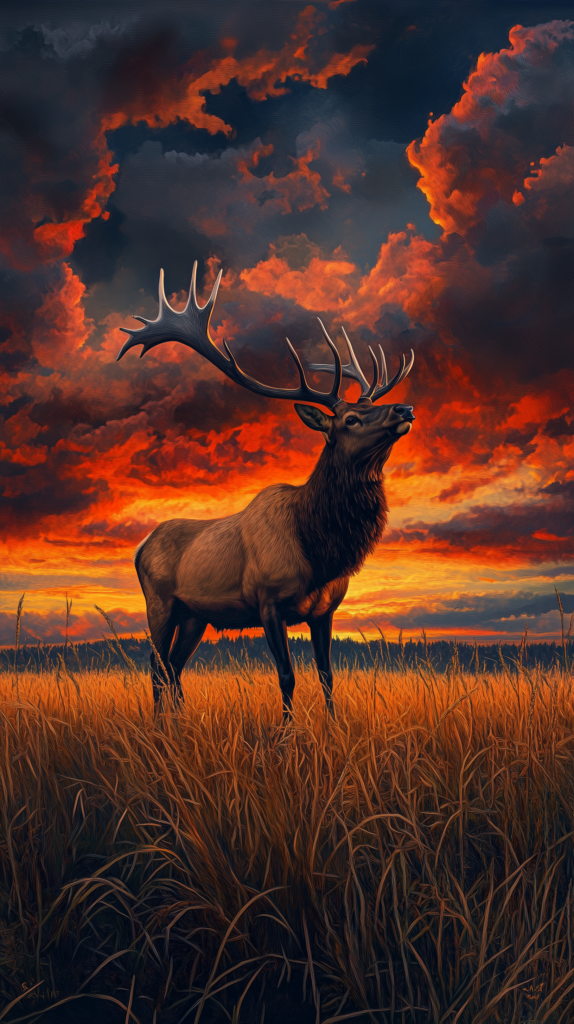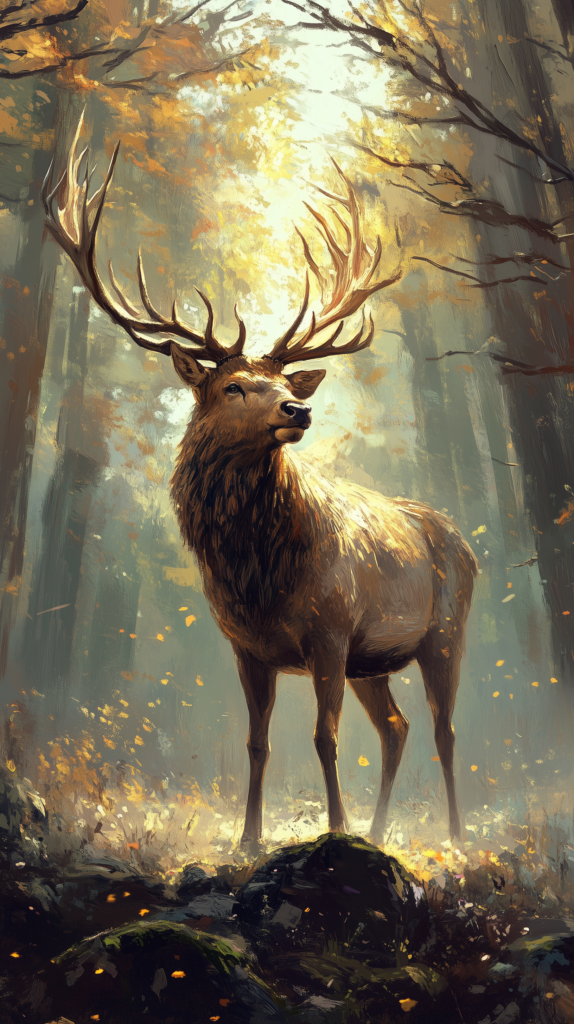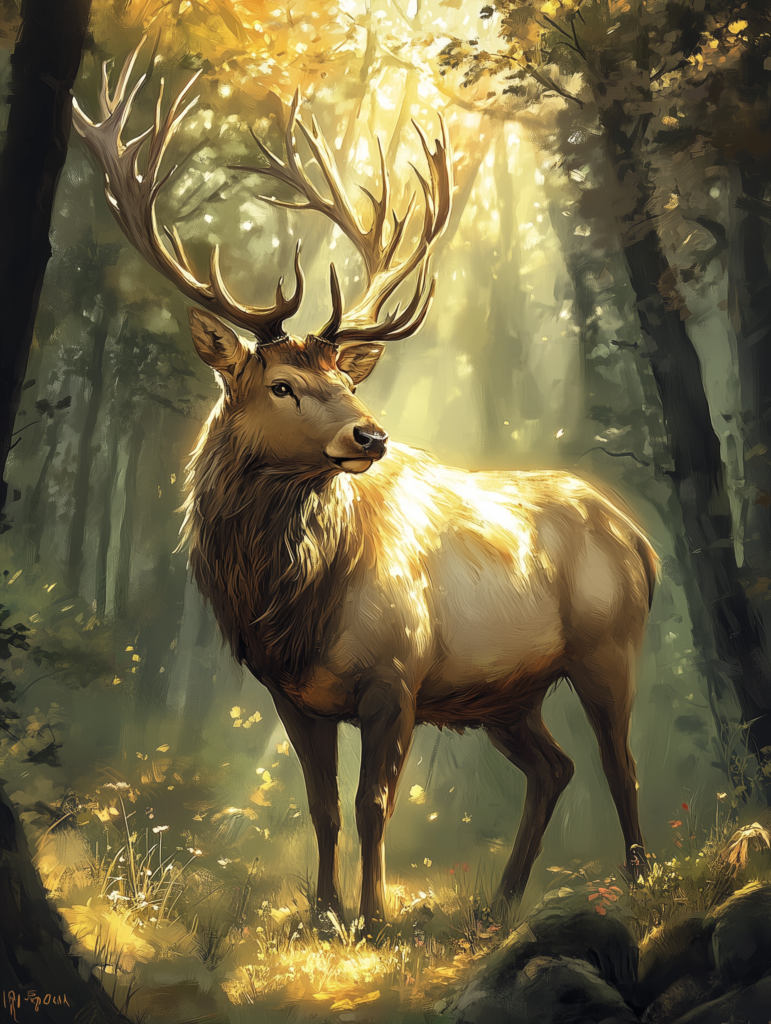Herd Animal, Elk: The Majestic Monarch of the Wild
“Discover the majestic creature whose eerie bugle echoes through the wild—meet the Elk, nature’s antlered powerhouse!”

The elk (Cervus canadensis) is a towering figure among deer species, with bulls standing up to 5 feet tall at the shoulder and weighing 700–1,100 pounds. Their sleek, reddish-brown summer coats darken to a thicker, grayish-brown in winter. Males are adorned with massive, sprawling antlers that can grow up to 4 feet long and are shed and regrown annually. A thick, dark mane graces their necks, contrasting with their pale, cream-colored rump patch and slender black legs, making them both robust and graceful.
Behavior:
Elk are highly social creatures, forming large herds dominated by females (cows) and their young, while bulls often form smaller bachelor groups outside of the mating season. During the fall rut, bulls become fiercely territorial, issuing piercing bugle calls to assert dominance and attract mates. They battle rivals with their antlers in dramatic clashes. Generally crepuscular, elk are most active during dawn and dusk, though they may adjust their behavior to avoid predators or human disturbance.
Habitat:
Native to North America and northeastern Asia, elk thrive in diverse environments ranging from dense coniferous forests to open grasslands and alpine meadows. They prefer areas with ample food and cover, often migrating seasonally to find lush grazing grounds in summer and sheltered lowlands in winter. In protected areas, elk are a common sight, but in the wild, they display a cautious wariness of predators such as wolves, bears, and mountain lions.
Modus Operandi:
Elk are quintessential grazers, meticulously feeding on grasses, forbs, shrubs, and even tree bark during scarce winter months. Bulls adopt a singular focus during the rut, driven by the need to secure a harem of cows. Year-round, their survival hinges on acute senses of hearing, sight, and smell, allowing them to detect threats and flee with surprising speed, reaching up to 40 miles per hour when necessary.
Motivation:
Elk are instinctively driven by the survival imperatives of food, safety, and reproduction. During the rut, bulls are motivated by the need to assert dominance and pass on their genes, while cows prioritize the care and protection of their calves. In harsh winters, the search for sustenance becomes paramount, guiding their movements and behaviors. Above all, elk embody resilience and adaptability, thriving in challenging ecosystems and playing a crucial role in their natural habitats.
Elk 5e
Elk Pathfinder
Elk

Elk range in great herds throughout the plains, hills, and forests of many wilderness areas. Their size, strength, and antlers allow them to contend with most of their environment’s dangers, though herds generally favor flight to combat. Elk also prove exceptionally adaptable survivors, capable of living through severe weather changes without concern. Most breeds of elk stand between 3 and 5 feet tall and weigh between 350 and 550 pounds, with females far slighter than the males.
Numerous species of elk exist. Some larger species can stand up to 6 feet tall at the shoulder and can be used as mounts by Medium humanoids; these elk have 3 Hit Dice and are Large. One particularly unusual species of elk, the river elk, is an excellent swimmer—these elk gain a swim speed of 30 feet. All elk of this size are CR 2 creatures.
This majestic beast stands the height of a man at its shoulders, a many-tipped rack of proud antlers crowning its head.
Elk CR 1
Source Bestiary 3 pg. 1 (Amazon), Pathfinder #31: Stolen Land pg. 80 (Amazon)
XP 400
N Medium animal
Init +3; Senses low-light vision; Perception +7
Defense
AC 13, touch 13, flat-footed 10 (+3 Dex)
hp 15 (2d8+6)
Fort +6, Ref +8, Will +2
Offense
Speed 50 ft.
Melee gore +3 (1d6+2), 2 hooves –2 (1d3+1)
Statistics
Str 14, Dex 17, Con 16, Int 2, Wis 15, Cha 7
Base Atk +1; CMB +3; CMD 16 (20 vs. trip)
Feats Lightning Reflexes, RunB
Skills Perception +7
Ecology
Environment cold or temperate plains
Organization solitary, pair, or herd (3–50)
Treasure none
Elk

Large beast, unaligned
Armor Class: 13 (natural armor)
Hit Points: 37 (5d10 + 10)
Speed: 50 ft.
| STR | DEX | CON | INT | WIS | CHA |
|---|---|---|---|---|---|
| 19 (+4) | 14 (+2) | 14 (+2) | 2 (-4) | 12 (+1) | 10 (+0) |
Saving Throws: Strength +6, Dexterity +4
Skills: Perception +3, Athletics +6
Senses: Passive Perception 13
Languages: —
Challenge: 1 (200 XP)
Traits
Keen Hearing and Smell.
The elk has advantage on Wisdom (Perception) checks that rely on hearing or smell.
Trampling Charge.
If the elk moves at least 20 feet straight toward a creature and then hits it with a Gore attack on the same turn, that target must succeed on a DC 14 Strength saving throw or be knocked prone. If the target is prone, the elk can make one Stomp attack against it as a bonus action.
Fleet-Footed.
The elk can take the Dash action as a bonus action.
Actions
Gore. Melee Weapon Attack: +6 to hit, reach 5 ft., one target.
- Hit: 14 (2d8 + 4) piercing damage.
Stomp. Melee Weapon Attack: +6 to hit, reach 5 ft., one prone creature.
- Hit: 15 (2d10 + 4) bludgeoning damage.
Legendary Actions (Optional for a “Legendary Elk”)
The elk can take 1 legendary action, choosing from the options below. Only one legendary action can be used at a time, and only at the end of another creature’s turn. The elk regains its legendary action at the start of its turn.
- Alert Step. The elk moves up to half its speed without provoking opportunity attacks.
- Territorial Roar (Costs 1 Action). The elk releases a powerful bellow. Each creature within 30 feet that can hear it must succeed on a DC 13 Wisdom saving throw or be frightened until the end of their next turn.
Tactics
- The elk will use Fleet-Footed to stay mobile, darting in and out of combat to avoid being surrounded.
- It opens combat with a Trampling Charge, aiming to knock a foe prone and follow up with a Stomp.
- Against groups, the elk prioritizes weaker-looking enemies to quickly reduce numbers. It may retreat temporarily to assess threats using Keen Hearing and Smell.
- If granted legendary actions, the elk uses Alert Step to reposition itself strategically and Territorial Roar to scatter weaker foes or disrupt coordinated attacks.
Description
This elk is no ordinary woodland creature but a proud, towering beast embodying the wild’s ferocity. Its antlers, sharp as spears, glisten with dew, and its powerful legs churn the ground with every step. Whether defending its herd or lashing out at invaders, it fights with a cunning mix of strength and speed, proving that even nature’s grazers are not to be underestimated.

 Buy me a coffee
Buy me a coffee